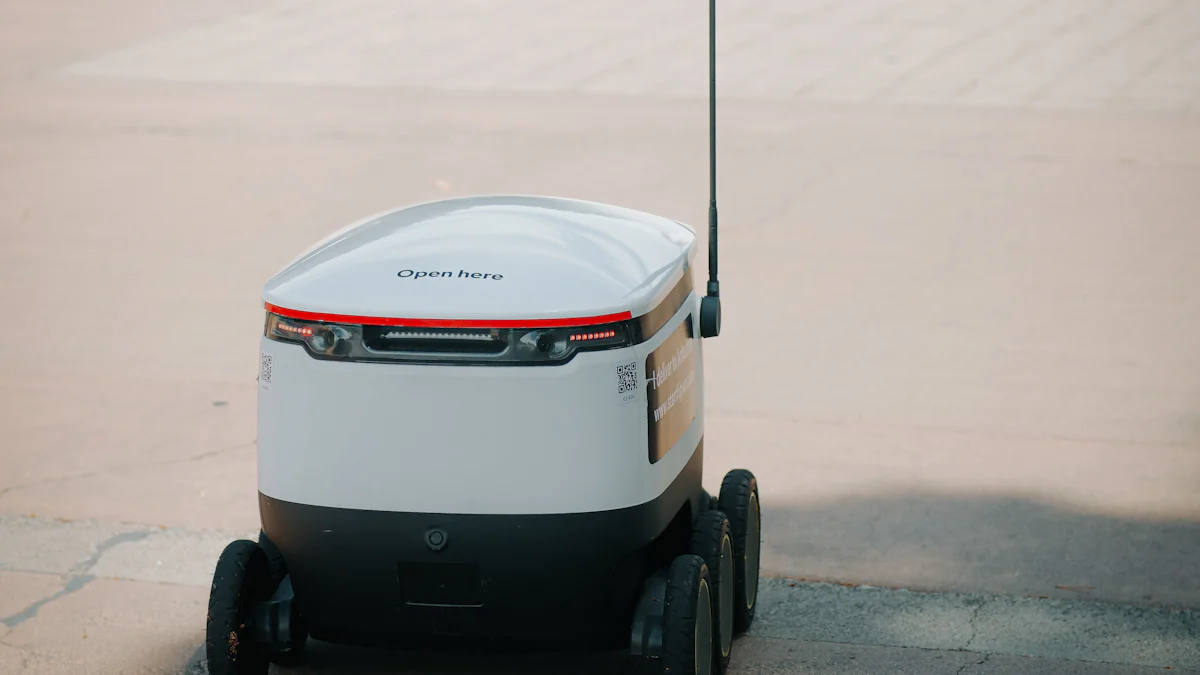Logistics Robotics: A Comprehensive Guide for 2024

In 2024, the realm of logistics robotics stands at the forefront of innovation and efficiency within modern supply chains. The integration of logistics robotics has become indispensable, optimizing operations and enhancing productivity. With key advancements like stacker cranes and picking arms, these robots streamline storage tasks and boost operational efficiency significantly. The market for logistics robots is on a rapid growth trajectory, driven by technological breakthroughs in AI, machine learning, and sensor technology. This surge in demand reflects the global shift towards automation to meet evolving industry needs.
Types of Logistics Robotics

In the realm of logistics robotics, various types of robots play pivotal roles in optimizing warehouse operations and enhancing efficiency. These robots, ranging from Mobile Robots to Robotic Arms and Automated Storage and Retrieval Systems (AS/RS), are revolutionizing the way goods are handled within distribution centers and storage facilities.
Mobile Robots
When it comes to mobile robots, two key players stand out: Automated Guided Vehicles (AGVs) and Autonomous Mobile Robots (AMRs). AGVs are designed to transport goods along predefined pathways with precision and reliability. On the other hand, AMRs offer flexibility in movement and navigation within warehouse environments, adapting seamlessly to dynamic operational needs.
Robotic Arms
Robotic arms are instrumental in tasks such as picking, packing, and palletizing products. These versatile tools streamline order fulfillment processes by handling items with speed and accuracy. Whether it's sorting items for shipping or preparing orders for delivery, robotic arms ensure seamless operations within warehouses.
Automated Storage and Retrieval Systems (AS/RS)
Automated Storage and Retrieval Systems (AS/RS) bring a new level of efficiency to warehouse logistics. Among these systems, Vertical Lift Modules (VLMs) and Carousels stand out for their ability to store and retrieve goods rapidly. VLMs utilize vertical space effectively, while Carousels offer high-density storage solutions for improved inventory management.
Warehouse logistics robots operate within distribution centers to automate various tasks related to material handling, inventory management, and order fulfillment. These robots streamline operations such as picking, packing, sorting, and shipping of goods, enhancing efficiency and accuracy in warehouse operations.
Fetch Robotics offers a range of robot models tailored to different warehouse tasks. The Freight series focuses on material transportation, while the HMI series emphasizes human-machine collaboration. The latest model from Fetch Robotics, the RollerTop, facilitates direct item transfer between conveyor belts and robots, streamlining the picking process.
In the e-commerce sector's fast-paced environment, Autonomous Mobile Robots (AMRs) have become indispensable for efficient logistics and warehouse automation. Their precision in material transport, order picking, and packaging is crucial in large fulfillment centers where speed is paramount.
The pick & place segment dominates the logistics robotics market by efficiently handling tasks in warehouse automation settings. This segment involves deploying robots that pick up items accurately from one location to another swiftly. In warehouses specifically, pick & place robots enhance order fulfillment accuracy by reducing assembly time for customer orders.
Applications of Logistics Robotics
Warehouse Operations
Logistics robotics revolutionize warehouse operations by enhancing picking and packing processes. With the integration of robotic systems, warehouses can efficiently handle inventory tasks with precision and speed. The utilization of logistics robotics in picking and packing ensures accurate order fulfillment while minimizing errors in product selection.
Efficient inventory management is a critical aspect of warehouse operations that benefits significantly from logistics robotics. By automating inventory tracking and organization, these robots streamline the storage process, ensuring optimal stock levels and reducing the risk of stockouts. The implementation of logistics robotics in inventory management leads to improved operational efficiency and cost savings for warehouse facilities.
Transportation
In the realm of transportation, goods movement is a key area where logistics robotics play a vital role. Automated guided vehicles (AGVs) and autonomous mobile robots (AMRs) are deployed to transport goods within warehouses seamlessly. These robots navigate through warehouse environments with precision, ensuring timely delivery of products to designated locations.
Last-mile delivery poses unique challenges in the logistics industry, which can be effectively addressed through the use of robotics. Logistics robots equipped with advanced navigation systems optimize last-mile delivery, ensuring swift and accurate distribution of goods to end customers. By leveraging robotics technology for last-mile delivery, companies can enhance customer satisfaction by offering faster delivery times and reliable service.
Order Fulfillment
Speed and accuracy are paramount in order fulfillment processes within warehouses, where logistics robotics play a crucial role. Robots equipped with advanced algorithms and sensors ensure high-speed order fulfillment, picking items accurately and efficiently for shipment. The integration of logistics robotics in order fulfillment operations accelerates the processing of customer orders, leading to improved operational efficiency.
Customer satisfaction is a key metric for measuring the success of order fulfillment operations, which can be enhanced through the use of logistics robots. By prioritizing speed and accuracy in order processing, companies can meet customer expectations effectively. Logistics robots contribute to customer satisfaction by streamlining order fulfillment processes, reducing lead times, and ensuring error-free deliveries.
By embracing logistics robotics across various applications such as warehouse operations, transportation, and order fulfillment, companies can optimize their supply chain processes for greater efficiency and productivity.
Future Trends in Logistics Robotics

The realm of logistics robotics is witnessing a transformative phase driven by technological advancements that are reshaping the landscape of supply chain operations. Advancements in AI and Machine Learning are at the forefront, revolutionizing how logistics robots operate within warehouses and distribution centers. These technologies empower robots to make intelligent decisions, optimize routes, predict demand patterns, and enhance overall operational efficiency.
Global projections indicate a substantial growth trajectory for logistics robotics, with the market expected to reach unprecedented levels by 2029. The integration of AI and machine learning algorithms into robotic systems is propelling this growth, enabling robots to adapt dynamically to changing environments and operational demands. This synergy between cutting-edge technologies is redefining the capabilities of logistics robots, making them indispensable assets in modern supply chains.
In parallel, the trend towards Increased Automation is driving companies to embrace robotics solutions for streamlining material handling processes and enhancing operational efficiency. By automating tasks such as palletizing, depalletizing, and transporting goods, logistics robots reduce manual labor requirements while accelerating order fulfillment procedures. This shift towards increased automation not only optimizes warehouse operations but also contributes to cost savings and improved productivity.
Furthermore, the integration of Logistics Robotics with the Internet of Things (IoT) is unlocking new possibilities for interconnected supply chain ecosystems. IoT-enabled sensors embedded within robotic systems facilitate real-time data exchange, enabling seamless communication between different components of the logistics infrastructure. This interconnected network enhances visibility, tracking capabilities, and predictive maintenance for logistics robots, ensuring optimal performance and minimal downtime.
As companies continue to invest in innovative technologies to stay competitive in a rapidly evolving market landscape, the convergence of AI, machine learning, automation, and IoT holds immense potential for shaping the future of logistics robotics. By harnessing these future trends effectively, businesses can unlock new opportunities for operational excellence, cost efficiency, and customer satisfaction in their supply chain operations.
The rapid evolution of logistics robotics is reshaping the landscape of supply chain operations, driven by advancements in artificial intelligence and machine learning. The industry is experiencing unprecedented growth and transformation as robotics applications optimize operations and meet customer demands effectively. With a projected market expansion to US$ 21450 million by 2029, logistics robots are revolutionizing warehouse automation and supply chain management. These robots enable efficient fulfillment of e-commerce demands through automation, enhancing efficiency and automating dangerous tasks within the logistics industry.
See Also
Revolutionizing Warehouse Efficiency with Logistics Robotics
Innovative Advances in Logistics Tech: Future Exploration
Uncovering Sustainable Robotics Trends in Supply Chain Management
